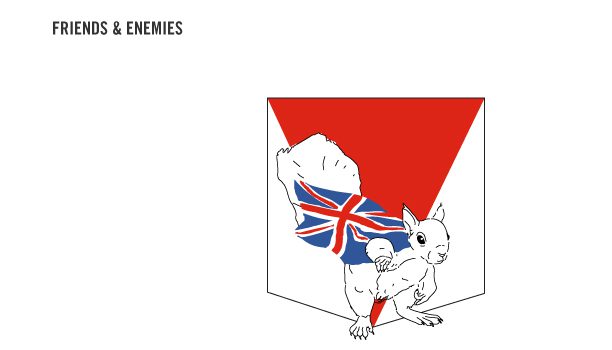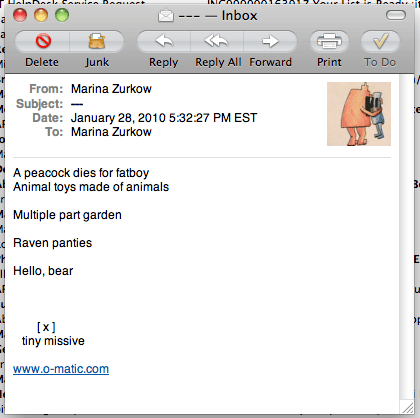Research Journal
-
March 30, 2010
#39 The Riddle of The World
Tags:(Poem #39) The Riddle of the World
Know then thyself, presume not God to scan
The proper study of Mankind is Man.
Placed on this isthmus of a middle state,
A Being darkly wise, and rudely great:
With too much knowledge for the Sceptic side,
With too much weakness for the Stoic’s pride,
He hangs between; in doubt to act, or rest;
In doubt to deem himself a God, or Beast;
In doubt his mind and body to prefer;
Born but to die, and reas’ning but to err;
Whether he thinks to little, or too much;
Chaos of Thought and Passion, all confus’d;
Still by himself, abus’d or disabus’d;
Created half to rise and half to fall;
Great Lord of all things, yet a prey to all,
Sole judge of truth, in endless error hurl’d;
The glory, jest and riddle of the world.— Alexander Pope
-
March 18, 2010
fucked up awesome books
Tags:Yes – say it like it is.
Sorry to be such a child, but I have no better language to describe how provocative, dark, pure (following the heart, following internal logic, following a line of inquiry), genre-bending, and ideologically challenging these works of fiction are.1. Bear, Marian Engel
2. An Episode in the Life of a Landscape Painter, César Aira
-
March 17, 2010
Put pressure on dolphin slaughter in japan
Just watched The Cove.
Besides its effectively genius simple mediation techniques (TVs strapped to protesting bodies in public spaces jihad-style; happy dolphin balloons armed with covert spycams), the fundamental argument is… unarguable. Dolphin slaughter should become an embarrassing harpoon in Japan’s public image.
– as top-of-the-food-chain eaters (like us), dolphin meat contains toxic levels of mercury (as much as 2000ppm, when safe consumption levels are .4 ppm);
– the yearly slaughter in Japan is an apparent add-on to the lucrative business of supplying tourist complexes with dolphins for swim n pet pools. Dolphins should not be kept in most or all captive situations, it causes high and depression to animals who need complex social and geographical ranges.
– most allegiances to Japan’s position on dolphin and whale killing are bought.You can take action by texting the word DOLPHIN to sms # 44144.
The movie’s populist/activist site is here.I followed the rather complex discussion on H-Net’s H-Animal after the SeaWorld killing of trainer Dawn Brancheau by the orca named Tilikum. What I’m going to note is a stretch, I admit, but not unlike eating meat (which I do), in which the animal in its natural state has long disappeared and what you are left with is something delectable, if not cleanly packaged, animals in zoos and aquaria are easy to perceive as a packaged commodity, far removed (even with info graphics as to their origin and natural ways of life). Neither eating meat nor consuming animals as entertainment – even when framed as sustaining or nourishing or educational – is defensible.
As usual, a better summary lies elsewhere.
Excerpt from Andrew Revkin’s dot.earth, one of the NY Times’ blogs:I asked Carl Safina, the marine biologist, ocean campaigner and author, whether he thought utilitarian or ethical arguments dominated the film. Here’s what he said:
The film is an astonishing achievement. On your question about our relationship with fellow species, this question can be debated along several lines: sustainability, human health, humaneness, and our relationship with other species.
Killing the dolphins in those numbers is clearly sustainable.
Their meat is high in mercury but eating a little won’t hurt you, although eating it routinely could cause problems.
The dolphins are capable of panic and pain, both of which they suffer in this hunt. For millenniums, seafarers and shore-dwelling people have almost universally found dolphins to be beautiful and inspiring, and for that reason as well as their high intelligence, the human relationship with them has been special.
However, I’m uncomfortable forcing my values on other people. I like to catch and eat fish; some people understandably find that immoral. Eating dolphins is also unnecessary, but we all like to do a lot of unnecessary things, from playing baseball to going for a drive on a Sunday to eating hamburgers. And certainly Americans kill and eat tremendous numbers of cattle, which, like dolphins, are warm-blooded mammals that suckle their young.
But perhaps the most universal hallmark of human progress is the desire to minimize infliction of suffering. We have strict codes for how animals slaughtered for food must be killed, and much of it has to do with lessening their suffering.
The main problem with killing marine mammals — a much bigger problem than whether a small amount of killing is sustainable — is that it is cruel. Every real advance in human thought has had to do with expanding our circle of compassion. Cruelty to animals seems to parallel cruelty to people. So, I think the international condemnation of the dolphin killing is fair enough. There is no denying the fact that it is brutal business.
Personally, I detest the dolphin killing. One cultural aspect is worth noting: it is curious that the Japanese hunt seems to arouse more ire than the Faeroese pilot whale hunt, which is equally gruesome. Perhaps this is mere cultural bigotry. Perhaps it is because Japan’s behavior regarding dolphins, whales and fishing is so outside global norms. And because their policies in international bodies such as fisheries commissions, the whaling commission, and the Convention on International Trade in Endangered Species are disruptive enough to have global consequences.
Another fascinating aspect of the film that I discussed was simply that Mr. Psihoyos had perfected a new way of telling true stories that is something other than journalism — and fills a gap as the resources and reach of traditional media shrink.
With small high-definition cameras and the power of the Web, anyone — from a community activist to a journalism student — can now document and disseminate imagery on issues that matter. Also, activists have recruited enough supporters (Bob Barker buying a ship for the Sea Shepherd Conservation Society, for instance) that they can patrol the vast southern ocean tracking Japan’s whaling fleet when the media, and even other governments, are unable to do so. In the end, as I’ve been saying lately, it appears that traditional media are a shrinking wedge of the expanding pie of global electronic storytelling. “The Cove” is an example of someone creatively filling the void.

image from Encyclopedia Brittanica's Advocacy for Animals +++
-
February 5, 2010
petrified faerie
From The Times Online, 2005.
What appears to be the mummified remains of a fairy have been discovered in the Derbyshire countryside… The remains were discovered by a local man, who wishes to remain anonymous, while walking his dog along an old Roman road situated between the villages of Duffield and Belper…The remains, complete with wings, skin, teeth and flowing red hair have been examined by anthropologists and forensic experts who can confirm that the body is genuine. (via Neatorama) Marcus Salter, head of Genesis Properties, estimates that the small colony of fairies believed to live beneath a rock in St Fillans, Perthshire, has cost him £15,000. His first notice of the residential sensibilities of the netherworld came as his diggers moved on to a site on the outskirts of the village, which crowns the easterly shore of Loch Earn. He said: “A neighbour came over shouting, ‘Don’t move that rock. You’ll kill the fairies’.” The rock protruded from the centre of a gently shelving field, edged by the steep slopes of Dundurn mountain, where in the sixth century the Celtic missionary St Fillan set up camp and attempted to convert the Picts from the pagan darkness of superstition.
-
-
-
January 17, 2010
Project proposals for Northumberland

The Red Squirrel of Britain (Sciurus vulgaris) Here are one-sheet descriptions of the proposals I made for Northumberland, that came out of my research residency in June 2009 at ISIS Arts in Newcastle.
There are three proposals: a street food cart serving invasive species; a garden feeder in human form; and an animated diptych. In addition, I have proposed a banquet of edible invasive species set on the high moors, pleine aire, in reformation style.
***
Animation test clips:
-
December 29, 2009
good writing, disheartening wrapups
Tags:Much good writing came out in response to the wan wrap up in Copenhagen. Sadly, and from a narrow telescope deservedly, Obama is the butt of some bitter wallops.
To name two in the post-haze of COP15:
Bill McKibben’s piece for Yale Environment 360, “Copenhagen: Things Fall Apart and an Uncertain Future Looms” (excerpt):
James Hansen, the great climate scientist who started the global warming era with his 1988 testimony before the U.S. Congress, and whose team provided the crucial 350 number that now defines the planet’s habitability, refused to come to Copenhagen, predicting it would be a charade. He was correct. On Sunday he predicted a greater than 50 percent chance that 2010 would be the warmest year ever recorded. If you want to bet against him, you can. If you want to argue that this non-agreement will help Obama get something through Congress, it’s possible you’re right. If you want to despair, that’s certainly a plausible option.
Rebecca Solnit’s “Judgment Days in Copenhagen” for the Huffington Post (excerpt):
Thanks to a sudden decision earlier this month by the Environmental Protection Agency allowing the executive branch to address the issue of climate-change gases under the Clean Air Act, Obama has apparently been given superpowers to act without being completely hamstrung by a reluctant Congress. Or as the Center for Biological Diversity put it, “President Obama can lead, rather than follow, by using his power under the Clean Air Act and other laws to achieve deep and rapid greenhouse emissions reductions from major polluters.”
Will he? Probably not. After all, he’s the man who stood up in Prague last April and said: “I state clearly and with conviction America’s commitment to seek the peace and security of a world without nuclear weapons.” For a moment, it almost sounded as if he was going to be the action hero of our antinuclear dreams, wiping out one apocalypse that has hung over us for sixty years. And then he added that he didn’t actually expect to see the abolition of such weaponry in his lifetime, though he didn’t say why.
Now, we’re in an action movie in which the fate of the Earth is truly at stake, and the most powerful man on the planet has allowed himself to be hedged in by timidities, compromises, refusals, denials, and the murderous pressure of corporations. Those too-big-to-die corporations are the reason why the Senate is unlikely to ratify any climate-change treaty that threatens to do much of anything. Really, corporations — half-fictitious, semi-immortal behemoths endowed with human rights in the U.S. and possessed of corrosive global power — already are the ruthless cyborgs of our time. They are, after all, actively seeking a world in which they imagine that, somehow, they will survive, even if many of us and much that we love does not. Sorry poor people, young people, Africa, sorry Arctic summer ice, you’re not too big to fail.
-
-



